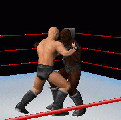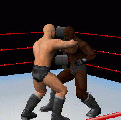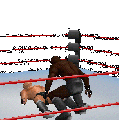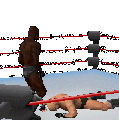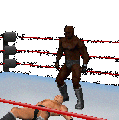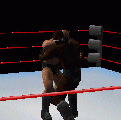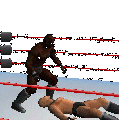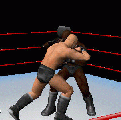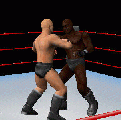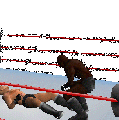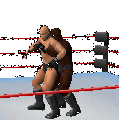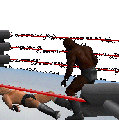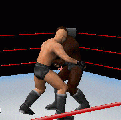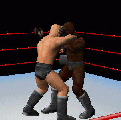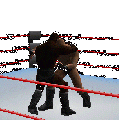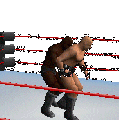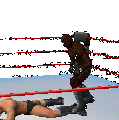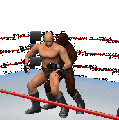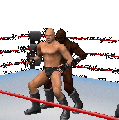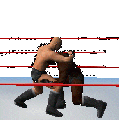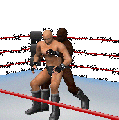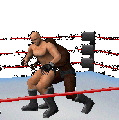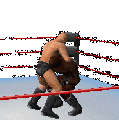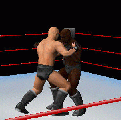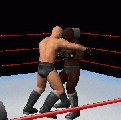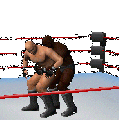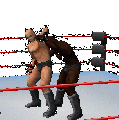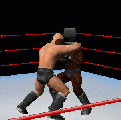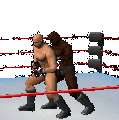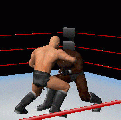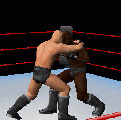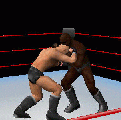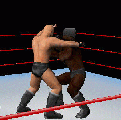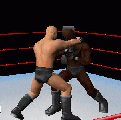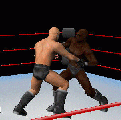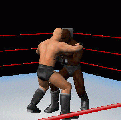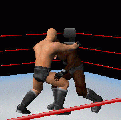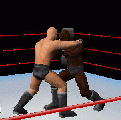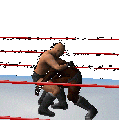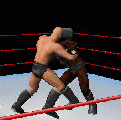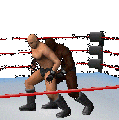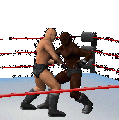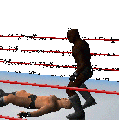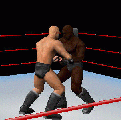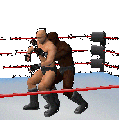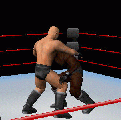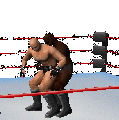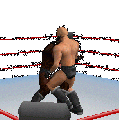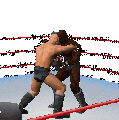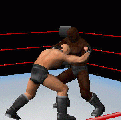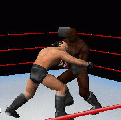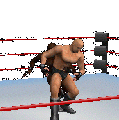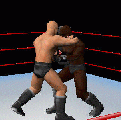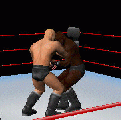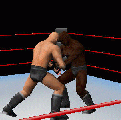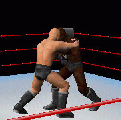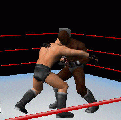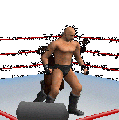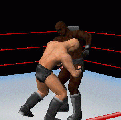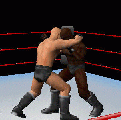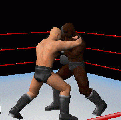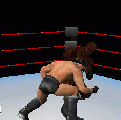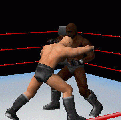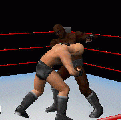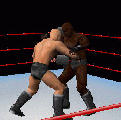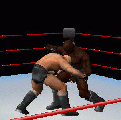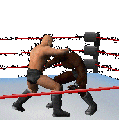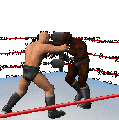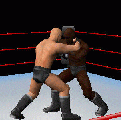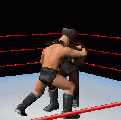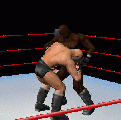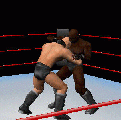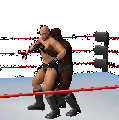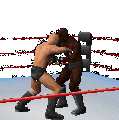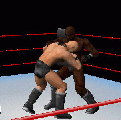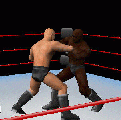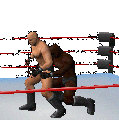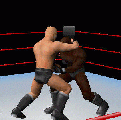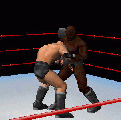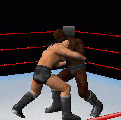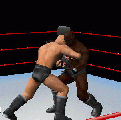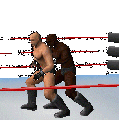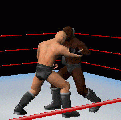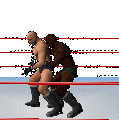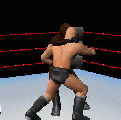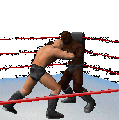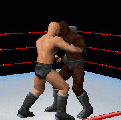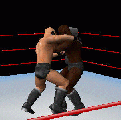|
|
| Line 222: |
Line 222: |
| | image:WCM_High_Angle_Slam.gif|'''High Angle Body Slam:''' Lifting opponent high over the shoulder, then slamming or throwing them down to the mat. | | image:WCM_High_Angle_Slam.gif|'''High Angle Body Slam:''' Lifting opponent high over the shoulder, then slamming or throwing them down to the mat. |
| | | | |
| − | image:WCM_Hurricanrana.gif|'''Hurricanrana:''' A head-scissors takedown, performed by jumping into the air, performing a head-scissors around the opponent's head, and using that grip to drag the opponent down to the mat. May be performed while running or standing. May be combined with Tornado movement (spinning around opponent, causing them to pivot), or a somersault. Can end in a Pin (double-leg cradle). | + | image:WCM_Hurricanrana.gif|'''Tilt-A-Whirl:''' A head-scissors takedown, performed by jumping into the air, performing a head-scissors around the opponent's head, and using that grip to drag the opponent down to the mat. May be performed while running or standing. May be combined with Tornado movement (spinning around opponent, causing them to pivot), or a somersault. Can end in a Pin (double-leg cradle). |
| | | | |
| | image:WCM_Hurricanrana_Standing_Mount.gif|'''Hurricanrana:''' A Hurricanrana from Standing, ending in a Mounted Position. | | image:WCM_Hurricanrana_Standing_Mount.gif|'''Hurricanrana:''' A Hurricanrana from Standing, ending in a Mounted Position. |
Revision as of 17:39, 1 October 2015
Wrestling Terminology
Wrestling moves include a tremendous array of variation. The moves upon which these variations are based, are generally basic in nature. Combining moves can also be performed, using word elements to describe what kind of actions (movements) a move involves:
Holds:
- Crab: Typically starts with one wrestler lying in a supine position on the mat, with the other wrestler standing and facing him. It is a type of spinal lock where the wrestler hooks each of the opponent’s legs in one of his arms, and then turns the opponent face-down, stepping over him in the process. The final position has the wrestler in a semi-sitting position and facing away from his opponent, with the opponent’s back and legs bent back toward his head.
- Nelson: Grappling hold, executed from behind the opponent, generally when both are on the mat face down with the opponent under the aggressor. One or both arms are used to encircle the opponent's arm under the armpit, and secured at the opponent's neck.
- Pin: A victory condition that is met by holding an opponent's shoulders or scapulae (shoulder blades) on the wrestling mat for a prescribed period of time.
- Sharpshooter: Begins with the opponent supine on the mat with the applying wrestler stepping between the opponent's legs with his/her left leg and wraps the opponent's legs at shin level around that leg. If the applier decides to cross the opponent's legs around his right leg, he has to cross the opponent's right leg over their left, or, otherwise, he has to cross his opponent's left leg over their right. Holding the opponent's legs in place, the wrestler then grabs the opponent's leg which he has crossed over the other and steps over him, flipping him over into a prone position before leaning back to compress his lower back. Also known by several other names including cloverleaf leg-lace Boston crab, standing reverse figure-four leglock, and Scorpion Deathlock.
Throws:
- Backbreaker:
- Brainbuster:
- Chokeslam:
- Cutter:
- DDT:
- Facebuster:
- Neckbreaker:
- Piledriver:
- Powerbomb:
- Powerslam:
- Stunner:
- Suplex:
Submission Holds
Bear Hug: A no-escape Submission hold, pinning the opponent's arms to their sides, squeezing to debilitate them. Occasionally referred to as "Canadian Lumber Vice Grip" by some.
Bear Hug: A grapple around the opponent's torso, squeezing to debilitate them. Leaning forward baring down on opponent, standing straight pulling opponent in, or lifting opponent off the ground are optional to apply leverage. Submission.
Boston Crab: An archetypal submission, performed by grabbing the opponent's legs, rotating them to a prone position if necessary, facing the opposite direction and pulling the legs back while sitting atop the waist to induce the stretch.
Camel Clutch: An archetypal submission, sitting atop opponent's back, grabbing opponent by the neck and chin, and pulling back so as to stretch opponent's torso, neck and spine.
Chinlock: Grabbing supine opponent from behind by placing hands around the neck and chin, placing knee behind opponent's upper back between shoulder blades, and pulling the head so as to stretch the neck and spine in a Submission hold.
Cobra Twist: Also known as an Abdominal Stretch. From behind the opponent, hooking one leg up, over and in front of one of the opponent's legs, followed by ducking under opposite arm, leaning forward, and performing a headlock that stretches the opponent's torso in a Submission.
Cross Arm Bar: From beside the opponent, lifting one of their arms, and holding it to the chest, while lowering to a supine position with legs on either side of the arm resting atop the opponent's chest, stretching the held limb in a Submission hold.
Crossface: A neck crank, wrapping both hands around opponent's face and pulling back, applying pressure to neck and shoulders in a Submission.
Tongan Death Grip: A submission performed by grabbing the opponent's throat. Opponent can be pushed down onto the mat, for continued effect.
Figure Four Leg Lock: Grasping face-up opponent's leg, perform a spinning toe-hold to grab the other leg, crossing the legs into a '4', falling to the mat to increase pressure on opponent's crossed legs.
Full Nelson: Also called the Nelson Hold. From behind opponent, slip one or both arms underneath opponent's armpits, locking hands behind opponent's neck and pushing opponent's head forward. Used as a Submission Hold.
Half Boston Crab: Also known as Half Crab or Single Leg Boston Crab. Performed by hooking one of the opponent's legs under one arm, turning opponent face-down, stepping over them and moving to a semi-sitting position over opponent's back, facing away and pulling leg back in order to stretch the limb.
Hammerlock: Grabbing opponents wrist, and rotating in a technical hold so as to bend the arm against opponent's back, forcing hand upward toward the opponent's neck to apply pressure to shoulder joint.
Hangman Choke: A two-handed grip around the opponent's neck or head. Opponent can be lifted into the air, or pushed down onto the mat for continued effect. After wear-down, opponent may be thrown or slammed. Used as a Submission.
Headlock: Also called a Reverse Chancery. Performed by wrapping an arm around the neck of an opponent, generally from the side of the opponent's head.
Octopus Hold: A Submission performed by standing behind the opponent, hooking one leg over the opponent's opposite leg, then forcing the opponent to one side, using an arm to trap one of the opponent's arms, and draping the free leg over the opponent's neck, forcing it downward.
Rear Naked Choke: A grounded version of a sleeper hold with an added body scissors. Used as a Submission hold.
Side Arm Lock: Performed by grabbing the opponent's arm, one hand over the opponent's shoulder and the other holding the opponent's wrist or forearm. Opponent may then be pushed forward, down onto the mat, while stretching the held arm. Performed as a Submission.
Sleeperhold: Performed from behind opponent, by wrapping an arm around the opponent's neck, pressing biceps against one side of the neck, and the inner bone of the forearm against the other side. The neck is squeezed tightly. May be combined with leg-scissors around the opponent's torso or thighs. Used as a Submission hold.
Tackle: A takedown involving lifting the opponent off the mat, so as to rotate them and slam them down back-first. Opponent may be pinned depending on how high up the tackle was performed. May be used as a Submission (Ground Bearhug) or Pin depending on where and how tightly the grapple was applied.
Half-Nelson Chokehold: Once popularly known as "Tazzmission". A half-nelson/sleeper combination Submission hold.
Throws
Atomic Body Toss: Grabbing the opponent low, and lifting them over the shoulder, before tossing them in a direction.
Back Body Drop: Aiming low, grabbing opponent, and lifting them straight up, then performing an overhead throw, tossing them backward.
Belly To Belly: Grabbing the opponent in a bearhug, then turning and slamming the opponent onto the mat.
Belly To Belly: Grabbing opponent in a bear hug, then falling backwards, releasing opponent, to slam them on their back.
Belly To Back: A grapple around the opponent's midsection, lifting and turning backward, to slam opponent front-down on the mat.
Blue Thunder: From behind, lifting the opponent in a carry, before performing a powerbomb slam.
Body Press Drop: Performing an overhead lift, holding opponent high in the air, then releasing by dropping them in front or behind. Can optionally perform a throw.
Reverse Brainbuster: A suplex move performed by pulling the opponent into an inverted headlock, then lifting them up, overhead, and then dropping opponent behind.
Fireman Carry: Bending over, standing to the side of opponent. Pulling the opponent's arm over the shoulder, distributing the opponent's body fully over the shoulders, one hand holding onto opponent's leg. Opponent may then be carried, thrown or slammed.
Giant Swing: Grabbing supine opponent's legs and pivoting rapidly, elevating opponent and swinging them in a circle. Opponent may be released in mid-air, or simply returned to the mat after rotating.
Hair Whip: Grabbing the opponent's head or hair, then swinging them around, so as to throw them in a direction. Opponent holds onto wrists, in order to avoid actual hair pulling.
Hangman Choke: A two-handed grip around the opponent's neck or head. Opponent can be lifted into the air, or pushed down onto the mat for continued effect. After wear-down, opponent may be thrown or slammed. Used as a Submission.
High Angle Body Slam: Lifting opponent high over the shoulder, then slamming or throwing them down to the mat.
Arm Toss: An arm-throw performed by grabbing the opponent's arm, twisting under it, and then dragging it down so as to pull opponent up, and drag them over-head, dropping them to the mat.
Monkey Flip: Also known as a Monkey Climb, performed by hooking both hands around the opponent's head, before bringing up both legs to place feet against opponent's hips/waist, followed by shifting weight so as to fall backwards, forcing opponent to fall with them. A toss is performed, by pushing up with legs and releasing the hands, so as to shove the falling opponent into the air.
Monkey Toss: Also known as Hip Toss, standing beside opponent, hooking closest arm underneath and behind opponent's closest armpit, then lifting up with that arm and throwing the opponent forward, flipping them onto their back. Distance may vary.
Northern Lights Suplex Release: Grabbing opponent around waist and performing a suplex, lifting opponent up and over, performing a leg bridge, before releasing opponent in mid-fall.
Oklahoma Slam: A slam performed by lifting the opponent up, holding them in a shoulder carry. The Oklahoma variant maintains a pause, used for appeal, before eventually slamming or throwing the opponent onto the mat.
Spine Buster: Performed by running into an opponent, lifting them, and slamming or throwing them down back-first onto the mat. May be performed from standing or running.
Scoop Slam: Body slams are any move where the opponent is picked up and thrown to the ground. The Scoop Slam is performed by facing the opponent, reaching between their legs with one arm, and reaching around the opponent's back from the same side with the other arm. The opponent is lifted, turned upside down, and then thrown to the mat back-first.
Pins
Arm Toss: An arm-throw performed by grabbing the opponent's arm, twisting under it, and then dragging it down so as to pull opponent up, and drag them over-head, dropping them to the mat.
Backdrop: A rear grapple, followed by lifting the opponent, swinging them overhead, backwards, and slamming them on the mat behind. Can continue holding for Pin.
Back Pin: Turning, grabbing the opponent in a double-arm hold, facing opposite direction, then leaning forward onto hands-and-knees so as to Pin the opponent's shoulders.
Bonzai Drop: A Pin performed as a drop-to-sit on top of a downed opponent's torso.
Double Wrist Suplex: Grabbing the opponent's wrists and holding them to the sides, before ducking under opponent's arm and standing, lifting opponent up and over, to perform a suplex. May remain holding for a Pin.
Full Nelson Suplex: A Nelson Hold followed by lifting the opponent up and over in a suplex. May continue to hold afterward for a Pin.
Northern Lights Suplex: Grabbing opponent around the waist and performing a suplex, lifting opponent up and over, and performing a back and leg bridge. Opponent can then be Pinned.
German Suplex: Also known as Belly-To-Back Waist Lock Suplex, or Back Arch Throw. Lifting opponent by the waist from behind up, and falling backwards while bridging the back and legs, to slam opponent's shoulders and upper back against the mat. Can continued to be held as a Pin.
Tilt-A-Whirl: A head-scissors takedown, performed by jumping into the air, performing a head-scissors around the opponent's head, and using that grip to drag the opponent down to the mat. May be performed while running or standing. May be combined with Tornado movement (spinning around opponent, causing them to pivot), or a somersault. Can end in a Pin (double-leg cradle).
Hurricanrana: A Hurricanrana ending in a pin.
Powerbomb: Performed by lifting the opponent into a sitting position upon the shoulders, then slamming them down onto the mat. May be held for a Pin.
Powerbomb Pin: Performed by lifting the opponent into a sitting position upon the shoulders, then slamming them down onto the mat, continuing to hold them in a Pin.
Schoolboy: Also called Schoolboy Sweep, performed by moving behind opponent, dropping to a knee, putting a hand through opponent's legs, hooking the opponent's hips, and pulling backwards. This causes the opponent to fall over and backwards with straightened and trapped legs, onto their back. May be finished with a Pin.
Tackle: A takedown involving lifting the opponent off the mat, so as to rotate them and slam them down back-first. Opponent may be pinned depending on how high up the tackle was performed. May be used as a Submission (Ground Bearhug) or Pin depending on where and how tightly the grapple was applied.
Tombstone Piledriver: Also known as a Kneeling Reverse Piledriver, performed by placing an arm between the opponent's leg, and the other arm on the opponent's opposite shoulder. The opponent is then lifted, similar to a Scoop Slam lift, into the Reverse Piledriver position, before falling or jumping down onto the knees, so as to drive the opponent's head and shoulders into the mat.
Attacks
Arm Breaker: A transition to a technical arm hold, holding opponent's arm over shoulder, then dragging it down against the shoulder in a wrench.
Arm Wrench: A transition to a technical arm hold, then dragging arm downward in a dislocating wrench.
Arm Wrench Neckbreaker: Turning opponent around while dragging arm across opponent's chest, then performing a neckbreaker.
Back Lariat: Swinging an arm against the back of the opponent's head/neck/shoulder in a Lariat.
Blue Thunder: From behind, lifting the opponent in a carry, before performing a powerbomb slam.
Reverse Brainbuster: A suplex move performed by pulling the opponent into an inverted headlock, then lifting them up, overhead, and then dropping opponent behind.
Bull Backbreaker: Moving the opponent to powerbomb position, the opponent is lifted, rotated and held, opponent's back resting on the shoulder as in a Canadian Backbreaker, before dropping to a knee in order to slam the opponent's back on the shoulder.
Bulldog: Grabbing the opponent in a mobile headlock, then moving forward and dragging the opponent by the head, jumping and dropping to a sit in order to slam the opponent face-down.
Buzzkiller: Grabbing opponent in a headlock, before falling back and to the side, lifting and dragging the opponent through the air in order to slam opponent's head against the mat.
Molly Bomb: A Hangman Choke, grabbing the opponent by the neck with both hands and lifting for either submission or wear-down, followed by slamming the opponent in a powerbomb.
Chokeslam: Grabbing the opponent by the neck, moving to the side, lifting the opponent in the air, and then slamming them down to the mat.
Coconut Crush: Grabbing the opponent's head, then slamming the opponent's skull against the knee.
DDT: Holding opponent in a front facelock or inverted headlock, then falling down or backward to drive opponent's head into the mat.
Tornado DDT: Perform a front facelock, then swing around opponent, falling backwards to perform the DDT by driving opponent's head into the mat.
"Dominator": Lift opponent to perform an inverted shoulder-carry as a Canadian Backbreaker, before slamming opponent forward onto the mat.
Double Arm Suplex: Grabbing the opponent's arms and holding them behind the opponent's back, before lifting them up and over, to perform a suplex.
Double Axe Handle: Grasping both hands together, slamming them down against a bent-over opponent.
Dragon Screw: A leg-whip, facing the opponent and grabbing the opponent's leg, holding it parallel to the mat, before spinning the leg inward, causing the opponent to twist as they lose balance and are brought to the mat in a turning motion.
Dropkick: Jumping up and kicking the opponent with the soles of both feet. May twist sideways in the air, so that one foot is higher than the other.
Enzuigiri: An attack that strikes the back of the head. Commonly, this is performed following a feint or counter, by stepping up the opponent's front, then performing a hook kick with the free leg to hit the back of the opponent's head
Face Crusher: Performed by grabbing the opponent's head and slamming it straight down onto the mat.
Falcon Arrow Suplex: Also called the Sitout Suplex Slam, or Suplex Driver, performed by applying front facelock, then draping opponent's near arm over the shoulder. Follow up by holding opponent's torso with free arm, lifting them into vertical position. Loosen facelock to twist opponent, falling to a sitting position and driving opponent's back and shoulders into the mat.
Reverse Falcon Arrow Suplex: Performed similar to Falcon Suplex, without twisting opponent, so as to have them land prone on the mat.
Full Nelson Slam: A Nelson Hold followed by lifting the opponent and slamming them to the mat.
Full Nelson Suplex: A Nelson Hold followed by lifting the opponent up and over in a suplex. May continue to hold afterward for a Pin.
German Suplex: Also known as Belly-To-Back Waist Lock Suplex, or Back Arch Throw. Lifting opponent by the waist from behind up, and falling backwards while bridging the back and legs, to slam opponent's shoulders and upper back against the mat. Can continued to be held as a Pin.
High Angle Body Slam: Lifting opponent high over the shoulder, then slamming or throwing them down to the mat.
Tilt-A-Whirl: A head-scissors takedown, performed by jumping into the air, performing a head-scissors around the opponent's head, and using that grip to drag the opponent down to the mat. May be performed while running or standing. May be combined with Tornado movement (spinning around opponent, causing them to pivot), or a somersault. Can end in a Pin (double-leg cradle).
Hurricanrana: A Hurricanrana from Standing, ending in a Mounted Position.
Jackhammer Suplex: Also known as a Suplex Slam, lifting opponent up and over in normal suplex vertical position, before shifting slightly in order to throw opponent to mat on their stomach. May be adjusted to throw opponent down on their back, similar to a High-angle Body Slam. Can also be used for other suplexes such as Fisherman Suplex or Gutwrench Suplex.
Arm Toss: An arm-throw performed by grabbing the opponent's arm, twisting under it, and then dragging it down so as to pull opponent up, and drag them over-head, dropping them to the mat.
"Kamakazi": A fireman carry variation, performed by bending over and dropping opponent onto their back, before rolling over them into a standing position.
Leg Trip: A move grabbing and lifting the opponent's legs, forcing them back or forward onto the mat.
Manhattan Drop: Also known as a Manhattan Drop, performed by ducking under opponent's shoulder, lifting them up, and dropping them hard against the knee.
Monkey Toss: Also known as Hip Toss, standing beside opponent, hooking closest arm underneath and behind opponent's closest armpit, then lifting up with that arm and throwing the opponent forward, flipping them onto their back. Distance may vary.
Neckbreaker: Grabbing the opponent's head and slamming their neck against the knee, head or shoulder.
Northern Lights Suplex: Grabbing opponent around the waist and performing a suplex, lifting opponent up and over, and performing a back and leg bridge. Opponent can then be Pinned.
Northern Lights Suplex Release: Grabbing opponent around waist and performing a suplex, lifting opponent up and over, performing a leg bridge, before releasing opponent in mid-fall.
Oklahoma Slam: A slam performed by lifting the opponent up, holding them in a shoulder carry. The Oklahoma variant maintains a pause, used for appeal, before eventually slamming or throwing the opponent onto the mat.
Pedigree: A facebuster, or faceplant, used as a takedown. Performed by grabbing hold of opponent's head or hair, and dropping to a knee in order to slam the opponent's face into the mat.
Pendulum Backbreaker: A backbreaker performed by standing side-to-side and slightly behind opponent, facing in same direction, followed by reaching around the opponent's torso with one arm across the opponent's chest (under both arms), and placing the other arm under the opponent's leg. Opponent can then be lifted up, and angled so as to be dropped down back-first against the knee.
Piledriver: Performed by grabbing the opponent, turning them upside-down, and driving them shoulder-first into the mat while falling into a sitting or kneeling position.
Powerbomb: Performed by lifting the opponent into a sitting position upon the shoulders, then slamming them down onto the mat. May be held for a Pin.
Reverse DDT: Also known as Inverted DDT, performed by applying inverted facelock, then falling backward (or moving backward while falling stomach-first) to drive the opponent's head into the mat.
Reverse Suplex: Also known as Inverted Suplex, performed by applying an inverted facelock with one arm from behind the opponent, using the other arm to aid in elevating opponent, lifting them up and holding them upside-down before falling onto back, driving opponent face-first into the mat.
Face Crusher: Performed by grabbing the opponent by the back of the head, and jumping forward into a sitting position, driving the opponent's face into the mat. May be performed from standing or running.
Spine Buster: Performed by running into an opponent, lifting them, and slamming or throwing them down back-first onto the mat. May be performed from standing or running.
Russian Leg Sweep: Performed by standing side-to-side and slightly behind opponent, facing same direction, then reaching behind the opponent's back to hook the opponent's head, with the other hand extending the opponent's nearest arm. Then, while hooking the opponent's leg, falling backwards, pulling the opponent to the mat back-first.
STF: The Stepover Toehold Facelock, performed by grabbing a face-down opponent's leg, and placing the opponent's ankle between the thighs, before lying on top of the opponent's back and locking both arms around the opponent's head and neck, before pulling back to stretch the opponent's back, neck and knee.
Scoop Slam: Body slams are any move where the opponent is picked up and thrown to the ground. The Scoop Slam is performed by facing the opponent, reaching between their legs with one arm, and reaching around the opponent's back from the same side with the other arm. The opponent is lifted, turned upside down, and then thrown to the mat back-first.
Lariat: Lariats are similar to clotheslines, however a clothesline maintains a straight arm, while the lariat is a strike that can hold. the Lariat is performed by wrapping the arm around the upper chest and neck, and forcing the opponent to the ground.
Showstopper Choke Slam: Grabbing the opponent by the neck, moving to the side, lifting the opponent in the air, and then slamming them down to the mat. The Showstopper variant includes a pause, holding the opponent in mid-air usually by one hand, before slamming them down.
Snapmare: Performed by applying a three-quarter-facelock, then kneeling or bending over to pull the opponent forward, flipping them over, shoulder-down to the mat, back-first.
Tackle: A takedown involving lifting the opponent off the mat, so as to rotate them and slam them down back-first. Opponent may be pinned depending on how high up the tackle was performed. May be used as a Submission (Ground Bearhug) or Pin depending on where and how tightly the grapple was applied.
Tombstone Piledriver: Also known as a Kneeling Reverse Piledriver, performed by placing an arm between the opponent's leg, and the other arm on the opponent's opposite shoulder. The opponent is then lifted, similar to a Scoop Slam lift, into the Reverse Piledriver position, before falling or jumping down onto the knees, so as to drive the opponent's head and shoulders into the mat.
